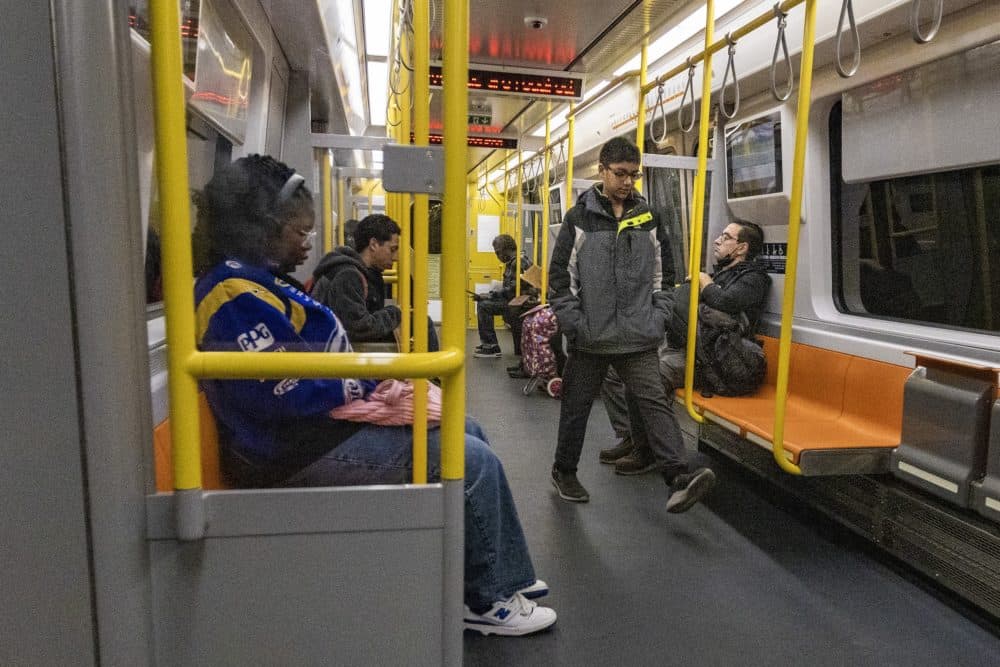Advertisement
Commentary
The T opened up the world to me. Now it's stuck

I’ve been riding the MBTA since the day my mom dropped me off at Alewife Station to take the Red Line to Charles River Esplanade, for free sailing lessons at Community Boating. That was back in 2001, when you could get through the fare gate by dropping a fistful of coins into a box. The fares and gates have since been updated, and nearly everything else is deteriorating.
On a Thursday earlier this month, around 10 p.m. — a time when many commuters have already gone to bed — the MBTA announced that “out of an abundance of caution,” slow zone speed limits of 10 to 25 miles per hour would be put in place across the entire subway system. At a press conference the following morning, the MBTA’s interim general manager Jeff Gonneville revealed the reason for such an extreme service reduction. The transit agency was missing documentation of track repairs — a discovery that was made when the Department of Public Utilities visited the stretch of the Red Line connecting Ashmont and Savin Hill and asked to see track repair documentation.
It was an escalation of the disruption and service reductions that MBTA riders have been forced to put up with over the last decade, especially after last summer’s grim Federal Transit Authority review of the MBTA. That report found glaring safety issues, including insufficient staffing levels and technical training — which isn’t too surprising given the anemic state of the MBTA’s operating budget. By 2024, the MBTA could face a $230 million deficit. But a lot of that looming deficit also comes down to the reality that the cost of MBTA operations and projects has long since exceeded the funds that Massachusetts governors and legislators have invested in our public transit system.
And these days, as countless MBTA riders deal with missing or molasses-slow trains, electrical fires, and derailments, most of our state lawmakers are silent or preoccupied with other matters: like gathering at the DraftKings HQ for a photo op to celebrate the recent legalization of sports betting in the Commonwealth. That’s where House Speaker Ron Mariano was on a Friday morning earlier this month, at the hour when many of us were waiting to find out why the MBTA subway network had suddenly been turned into a slow zone. Since the track repair documentation snafu was announced, the most productive thing we’ve heard about the MBTA from a high-level elected official is Gov. Maura Healey mulling possible means-tested fare discounts for low-income MBTA riders — hardly a novel idea, and one that doesn’t begin to approach the sizeable scale of what investments and structural changes are needed to resuscitate Greater Boston’s transit system.
This begs a question: Does anyone in power at the state level care that the MBTA is collapsing?
The Healey administration’s ongoing search for a new MBTA general manager offers faint hope that things might get better soon. But no matter who ends up accepting the job (I can’t imagine this is a job that candidates will be jousting for) any hopes for rehabilitation of the MBTA will be realized or ruined by state leaders who have acted with indifference as the MBTA corrodes and buckles. In 2020, when public transit advocates, Marty Walsh and the Greater Boston Chamber of Commerce implored the state legislature to raise additional revenue so the MBTA could avoid service cuts, Gov. Charlie Baker shot down the idea and leaders of the Democratic supermajority in the House and Senate stood by. It’s a familiar dynamic by now, which we’ve seen play out over the years. Transit advocates ask for deeper investment in the MBTA, to modernize our transit system and make it reliable enough to attract more riders, and lawmakers fret about the price.
But there wasn’t much fretting about fiscal sensibility last year when senior lawmakers allowed a surplus of over $3 billion in revenue to be largely doled out to the state’s wealthiest households in the form of tax credits. Nor have lawmakers expressed much concern about the costs that a malnourished and neglected transit system poses for riders. What is the price of delayed trains and buses for service workers who can be fired from their jobs for simply being late to work? Or the price of MBTA service reductions for students who rely on the MBTA to get to school daily? And on an existential level, what’s the cost of taking the T at the wrong time, in the wrong place?
For Robinson Lalin, a frequent transit rider whose arm was caught in the door of an MBTA Red Line train as it departed Broadway Station last April, the price of Massachusetts’ transit austerity amounted to dying in a horrific manner. It does not surprise me, in the wake of such an event, that more Massachusetts residents have abandoned the MBTA. But it fills me with both sorrow and anger, for what has been lost and what could be lost if transit-conscious leaders like Mayor Michell Wu are left to go it alone, in a state whose most visible leadership doesn’t seem to care.
When I was a kid, the MBTA opened the world to me. It was a viable pathway into a city where I saw glimpses of a happier life than I had found in the halls of my suburban middle school. At its best, public transit can unlock opportunities and discoveries for everyone within its radius. But for any transit system to reach its greatest potential, the leaders tasked with financing and overseeing that system also must believe in this potential. They have to want great transit too.
Otherwise, we’re stuck.

